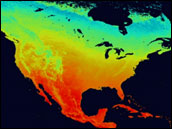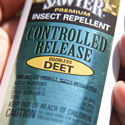
The 2003 West Nile Virus Maps provided by the Texas Department of Health give a summary and breakdown by human, bird, and equine infection reports for last year. In addition, TDH recommends that Texans protect themselves year around due to climate fluctuations and variations within the state.

This image shows land surface temperature data over a twelve-month period. Red indicates high temperatures, and blue indicates low.” (Credit data source: National Oceanic and Atmospheric Administration's (NOAA) Advanced Very High Resolution Radiometer (AVHRR) instrument, on board the POES series of satellites.)
TDH reports that fewer than 1 percent of those bitten by infected mosquitoes become severely ill. TDH recommends that if you have symptoms that include stiff neck, high fever, or severe headache, contact your health-care provider immediately. People over 50 years of age have the highest risk of severe disease.
The following is an adaptation of a TDH flyer, with a link provided for those who may wish to print and distribute this information to such as church memberships, assisted living facility residents, and school children for their families:
What you need to know about . . .West Nile Virus
What is it?
West Nile virus is a virus commonly found in Africa, West Asia and the Middle East. It is not known how long it has been in the United States, but the Centers for Disease Control and Prevention (CDC) believe the virus probably has been in the eastern United States since early summer 1999. It is closely related to St. Louis encephalitis virus found in the United States. The virus can infect humans, birds, mosquitoes, horses and some other animals.
How can I reduce my risk of getting West Nile virus?
Preventing mosquito bites is the best way to avoid getting West Nile virus. Remember the “Four Ds” of DEET, Dress, Dusk and Dawn, and Drain:

Visit this updated EPA link to learn about DEET.



What are the symptoms?
Most people infected with West Nile virus will not have any signs of illness. Twenty percent of people who become infected will have mild symptoms such as fever, headache, body aches and occasionally a skin rash on the trunk of the body and swollen lymph glands.
The symptoms of severe infection (West Nile encephalitis or meningitis) include headache, high fever, neck stiffness, stupor, disorientation, coma, tremors, convulsions, muscle weakness and paralysis. Only about one out of 150 people infected with West Nile virus will develops this more severe form of the disease.
The incubation period of West Nile virus in humans is three to 14 days. Symptoms of mild disease may last a few days. Symptoms of severe disease may last several weeks, although neurological effects may be permanent. Rarely, death can occur.
How is it spread?
West Nile virus is spread by the bite of an infected mosquito and can infect people, horses, many types of birds and some other animals. There is no evidence that West Nile virus can be spread from person to person or from animal to person.
Who is at risk for West Nile virus?
People over 50 years of age have the highest risk of severe disease. It is not known if people with weakened immune systems are at an increased risk for West Nile virus.
How is West Nile virus treated?
There is no specific treatment for West Nile virus infection. In severe cases, intensive supportive therapies are indicated, such as intravenous fluids and medicine to control fever or pain. Antibiotics may be given for any secondary bacterial infection.
Can I be vaccinated for West Nile virus?
Currently there is no vaccine for West Nile virus, but several companies are working toward developing a vaccine.
Is this a seasonal virus?
West Nile encephalitis cases usually occur in the late summer or early fall. However, Texas has a variety of climates; and when temperatures are mild, West Nile virus can be transmitted year round. It is best to try to protect yourself all year.
How likely am I to be bitten by an infected mosquito?
Fewer than 1 percent of those bitten by infected mosquitoes become severely ill. If you have the symptoms mentioned on this flyer, contact your doctor immediately.
Where can I get more information?
Contact your local health department. West Nile virus information can be found on the Texas Department of Health Web site at http://www.tdh.state.tx.us
and the CDC Web site at: http://www.cdc.gov/ncidod/dvbid/westnile/index.htm.
The following link is provided for those who may wish to print and distribute this informational flyer in Spanish:
Lo que usted debe saber acerca. . .
El virus West Nile
[Virus del Nilo Occidental]
¿Qué es este virus?